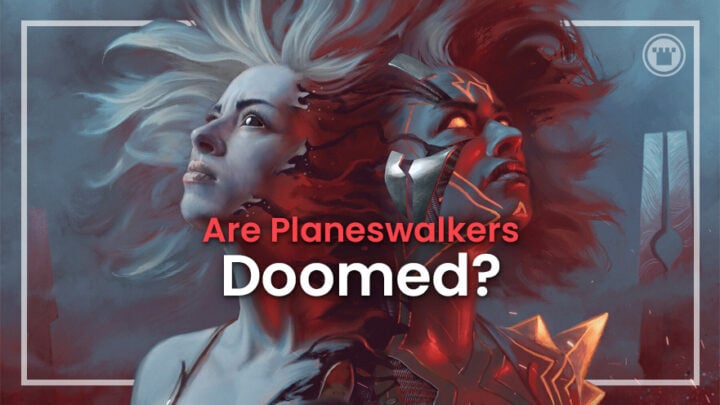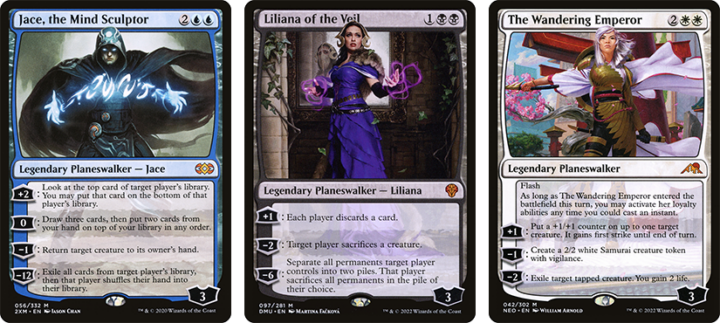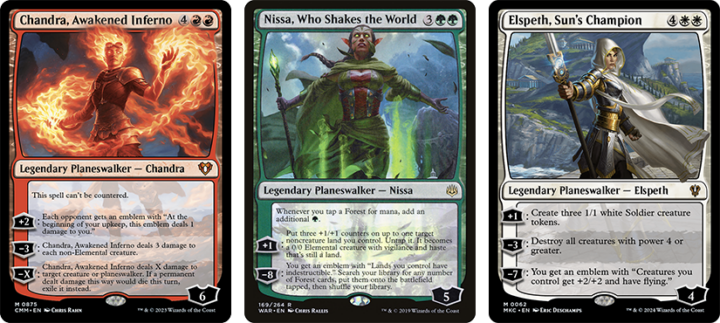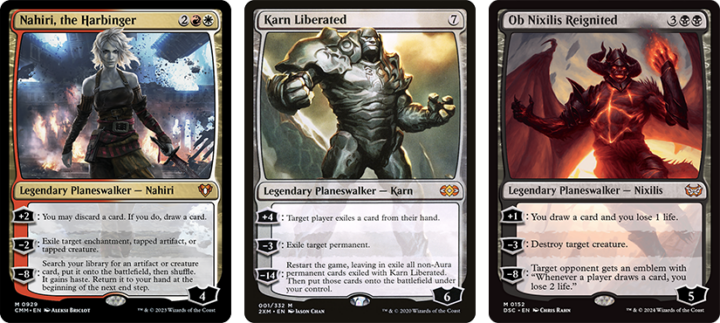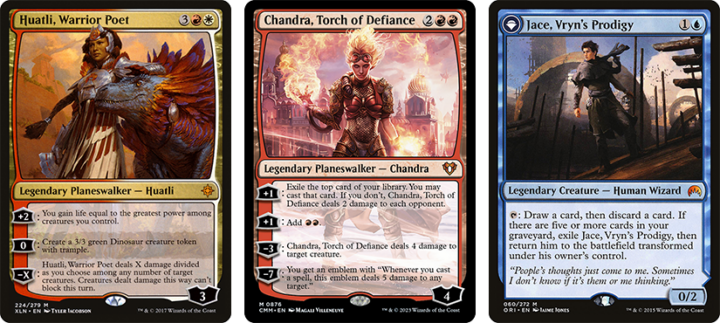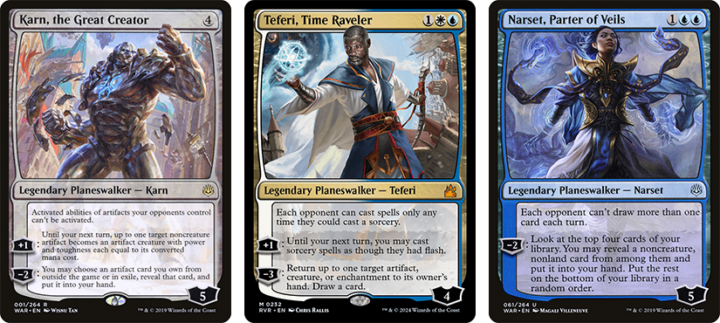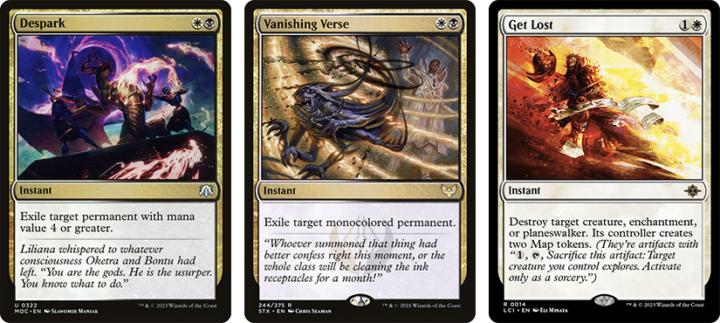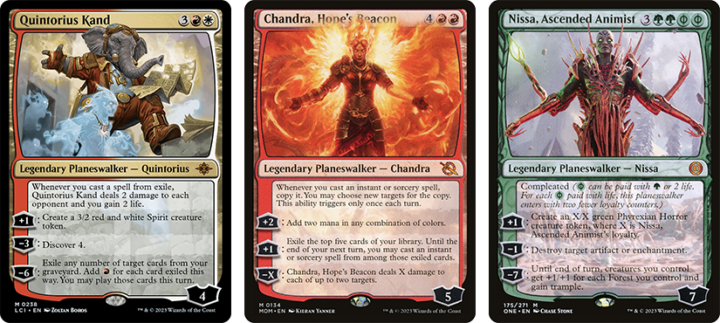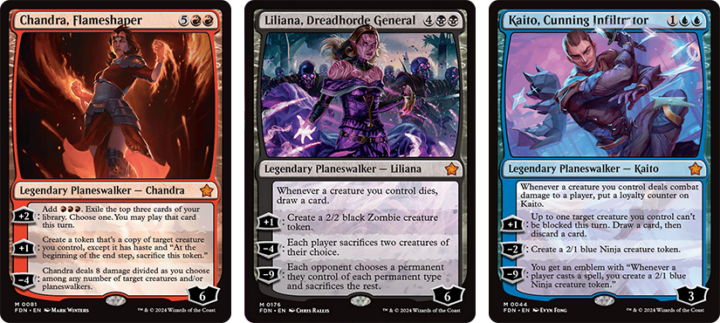For almost 20 years now, Planeswalkers have been central to Magic’s identity as a game. The Gatewatch (along with other notables like Sarkhan, Ral, Vraska and Sorin) established a recurring central cast for the game’s storyline. They created marketable, consistent mascots for their respective color combinations and home planes. By these business-centric measures, Planeswalker cards have been an unmitigated success.
But their impact on Magic’s gameplay has often been more controversial. After a few experiments, Planeswalkers soon became a defining force in every Constructed metagame, going from strength to strength all through the last decade.
Love them or loathe them, it seemed like both business and balance factors pointed to an important role for Planeswalkers well into the future. Instead we’re seeing a decline: in fan excitement for new Walkers, how many are printed, and in their usage across different formats. What has gone wrong for Magic’s erstwhile poster children?
ARE WE WALKING IN CIRCLES?
Whether or not Magic “should” try to balance around Planeswalkers as its top-tier threats is a subjective preference. But there are some more serious long-standing complaints about their design too: not least the accusation that (for a while) most of them seemed locked into a very specific pattern of abilities.
The “default” planeswalker loadout of “uptick for card advantage, downtick for removal, ultimate win the game” was never completely dominant even in its heyday through the early and mid 2010s. But Magic’s collective memory is heavily biased towards the cards which become ubiquitous as Constructed staples, and it was usually the “default” planeswalkers on top of the metagame. Jace the Mind Sculptor. Liliana of the Veil. Nahiri, the Harbinger. Ob Nixilis Reignited. Elspeth, Sun’s Champion. Karn Liberated. Vraska, Relic Seeker.
Swap card draw and removal for token-creation and team-pump, and you have most of the other cards which made an impact in this time, such as Nissa, Voice of Zendikar or Sorin, Lord of Innistrad. I’ve written before about how Planeswalkers can be analyzed as “minigames”, but a lot of these felt more like multiple-choice questions (or simply yes/no questions, given the very limited role of those ultimates). Beyond the tiresome repetition, this narrow model for success seemed to suggest that the viable design space for Planeswalkers might not be as expansive as was originally hoped.
The card type was envisioned as a more lively, dynamic version of value-over-time enchantments like Phyrexian Arena. But Phyrexian Arena is still arguably a best-in-class effect at three mana: you add flexible utility to that value engine, you end up with a spell that essentially has to cost four or more. Once you’re paying that much, you can’t really afford to have a design that can “miss” just because you’re behind on board, or playing against a creatureless control deck. No wonder Wizards seemed locked into the one set of boring, functional abilities!
THE SPARK IS GONE
Rather than be discouraged by this, Wizards continued to pump out new Planeswalker cards in both the interesting-but-unplayable mold (Huatli, Warrior Poet) and the dull-but-reliable one (Chandra, Torch of Defiance). The biggest success in terms of novel, playable designs was the “flip-Walker” cycle from Magic Origins. Great and inventive cards for sure, but ones which could also simply be a case of less mana = better (especially factoring other top Walkers of the day like Torch of Defiance or Gideon of the Trials).
This growing drive to innovate novel Planeswalker designs culminated spectacularly in mid-2019 with War of the Spark. It still stands out as Magic’s most Walker-centric set of all time – and not coincidentally, also the high point in an era of historic power creep.
Planeswalkers with static abilities and aggressively low mana costs significantly expanded the role that the card type could play in Constructed decks. Instead of powerful but vulnerable “objectives” which players needed board control to defend, now Planeswalkers could be outright tempo-positive and justify their cost with a single activation.
A card like Teferi, Time Raveler isn’t comparable to an upkeep-trigger enchantment, so much as it is a powerful sorcery which then also forces the opponent to remove a vestigial permanent to prevent an even bigger return.
This set broke so much new ground in terms of Planeswalker design space that it seemed like we’d be seeing iterations on those ideas for years to come. Sure, a few of the static ability walkers turned out to be toxically unpopular and ban-worthy, but the issue there was printing oppressive prison effects that only applied to one player, not what card they were printed on. Just come up with more flavorful and exciting static abilities and let the Planeswalker train roll on, right?
In hindsight though, WAR might be better understood as hitting the ceiling of how the Planeswalker card type could adapt to fit the post-“FIRE Design” gameplay paradigm. Incidental card advantage became more and more ubiquitous across all colors and card types, making mana the more important resource to optimize around.
Simultaneously, the increased lethality and efficiency of removal (including for Planeswalkers – the nasty hangover from WAR) made it ever-more important for expensive spells to frontload value as much as possible, to avoid being blown out by an immediate Despark. The fundamental rules of the card type made Walkers a poor fit for this kind of gameplay; they almost had to be 3-mana cantripping static abilities just to keep up!
NOTHING WORTH DYING FOR
I don’t really think we’re that close to running out of ideas for Planeswalker cards, even competitively playable ones. The decision to reduce the average number included in Standard sets struck me as being more about making room on the mythic rare sheet to print more legendary creatures. But what about the (much smaller) field of ideas which are useful to the 2020’s Magic player?
Whether it’s due to the overall lower costs and greater consistency speeding up the game or the inherent pressures of multiplayer (which took over as the game’s major format in that time) doing one small-ish thing a turn feels irrelevant compared to any triggered ability which can go off multiple times a turn cycle
It feels especially irrelevant to try and design Planeswalker abilities as part of some intricate, multi-stage minigame when it has become so easy to remove or attack down most planeswalkers before those plans can bear fruit. Planeswalker cards can still see play, but they need to be built with a twist on the original concept that helps them front load more value as a hedge against immediate demise. This might be a WAR-style static or triggered ability like Quintorius Kand and Chandra, Hope’s Beacon, a cost-discount like the “compleated” walkers with their Phyrexian mana costs, or ways to cheat around the hard cap on loyalty activations per turn.
No longer novelties or experiments, these features have become near-mandatory: only four Planeswalkers from the last two years have been printed without such a crutch, and none within the last 12 months. It’s just too big a commitment to play these cards otherwise, and you can’t make them much cheaper because their ceiling is usually still “game-winning” if they are lucky enough to survive a few rounds.
Unfortunately that happy ending also seems further away than ever before: even if you dodge or counter all the enemy removal spells, there’s a very good chance your Planeswalker will be overwhelmed by attacking creatures. It’s not even that you can’t put together a good team of blockers to stop this sort of thing; it’s just that so many creatures are now just as good at generating value as your Planeswalkers are! And if you already got the main chunk of value back from landing an immediate downtick activation, who could possibly justify sacrificing the more flexible and arguably harder to answer game piece – the creature – to preserve your Walker’s vestigial husk?
WALKING AWAY FROM IT ALL
Are we on the gradual road to Planeswalker extinction? I wasn’t so sure a week ago, but the announcement of a brand-new cycle of mythic rares for Foundations seems to have reaffirmed Wizards’ commitment to the idea. Regardless of their fortunes in the metagame, there’s no obvious replacement for the role Planeswalkers occupy in Magic’s branding and marketing. Wizards may be making things all about Captain America and Fortnite and Spongebob Squarepants in the near future, but the game will still need to have some symbols and concepts they actually own!
That said, the fact we saw such a drastic move as canonically eliminating the majority of Planeswalkers from the lore suggests a reduction in perceived future demand for the card type, to say the very least. It’s become apparent to all of us that designing balanced, interesting Planeswalker cards for the Commander-centric era of Magic is one of the hardest things to do, so reducing the expected quota of such designs seems like a natural adjustment to make. The extension of Standard rotations (and now the re-introduction of a pseudo-Core Set with Foundations) should avert any potential scenario where one or two colors flaunt a “Planeswalker gap” over other archetypes. And if that somehow does become a problem, well, at least it will prove the game’s youngest evergreen card type isn’t already over the hill.

Tom’s fate was sealed in 7th grade when his friend lent him a pile of commons to play Magic. He quickly picked up Boros and Orzhov decks in Ravnica block and has remained a staunch white magician ever since. A fan of all Constructed formats, he enjoys studying the history of the tournament meta. He specializes in midrange decks, especially Death & Taxes and Martyr Proc. One day, he swears he will win an MCQ with Evershrike. Ask him how at @AWanderingBard, or watch him stream Magic at twitch.tv/TheWanderingBard.

